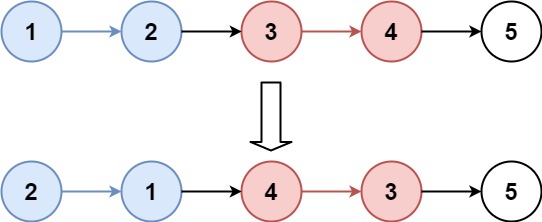[LeetCode] 25. Reverse Nodes in k-Group 每k个一组翻转链表
Given the head of a linked list, reverse the nodes of the list k at a time, and return the modified list.
k is a positive integer and is less than or equal to the length of the linked list. If the number of nodes is not a multiple of k then left-out nodes, in the end, should remain as it is.
You may not alter the values in the list's nodes, only nodes themselves may be changed.
Example 1:

Input: head = [1,2,3,4,5], k = 2 Output: [2,1,4,3,5]
Example 2:

Input: head = [1,2,3,4,5], k = 3 Output: [3,2,1,4,5]
Constraints:
- The number of nodes in the list is
n. 1 <= k <= n <= 50000 <= Node.val <= 1000
Follow-up: Can you solve the problem in O(1) extra memory space?
这道题让我们以每k个为一组来翻转链表,实际上是把原链表分成若干小段,然后分别对其进行翻转,那么肯定总共需要两个函数,一个是用来分段的,一个是用来翻转的,以题目中给的例子来看,对于给定链表 1->2->3->4->5,一般在处理链表问题时,大多时候都会在开头再加一个 dummy node,因为翻转链表时头结点可能会变化,为了记录当前最新的头结点的位置而引入的 dummy node,加入 dummy node 后的链表变为 -1->1->2->3->4->5,如果k为3的话,目标是将 1,2,3 翻转一下,那么需要一些指针,pre 和 next 分别指向要翻转的链表的前后的位置,然后翻转后 pre 的位置更新到如下新的位置:
-1->1->2->3->4->5 | | | pre cur next-1->3->2->1->4->5
| | |
cur pre next
以此类推,只要 cur 走过k个节点,那么 next 就是 cur->next,就可以调用翻转函数来进行局部翻转了,注意翻转之后新的 cur 和 pre 的位置都不同了,那么翻转之后,cur 应该更新为 pre->next,而如果不需要翻转的话,cur 更新为 cur->next,代码如下所示:
解法一:
class Solution { public: ListNode* reverseKGroup(ListNode* head, int k) { if (!head || k == 1) return head; ListNode *dummy = new ListNode(-1), *pre = dummy, *cur = head; dummy->next = head; for (int i = 1; cur; ++i) { if (i % k == 0) { pre = reverseOneGroup(pre, cur->next); cur = pre->next; } else { cur = cur->next; } } return dummy->next; } ListNode* reverseOneGroup(ListNode* pre, ListNode* next) { ListNode *last = pre->next, *cur = last->next; while(cur != next) { last->next = cur->next; cur->next = pre->next; pre->next = cur; cur = last->next; } return last; } };
我们也可以在一个函数中完成,首先遍历整个链表,统计出链表的长度,然后如果长度大于等于k,交换节点,当 k=2 时,每段只需要交换一次,当 k=3 时,每段需要交换2此,所以i从1开始循环,注意交换一段后更新 pre 指针,然后 num 自减k,直到 num<k 时循环结束,参见代码如下:
解法二:
class Solution { public: ListNode* reverseKGroup(ListNode* head, int k) { ListNode *dummy = new ListNode(-1), *pre = dummy, *cur = pre; dummy->next = head; int num = 0; while (cur = cur->next) ++num; while (num >= k) { cur = pre->next; for (int i = 1; i < k; ++i) { ListNode *t = cur->next; cur->next = t->next; t->next = pre->next; pre->next = t; } pre = cur; num -= k; } return dummy->next; } };
我们也可以使用递归来做,用 head 记录每段的开始位置,cur 记录结束位置的下一个节点,然后调用 reverse 函数来将这段翻转,然后得到一个 new_head,原来的 head 就变成了末尾,这时候后面接上递归调用下一段得到的新节点,返回 new_head 即可,参见代码如下:
解法三:
class Solution { public: ListNode* reverseKGroup(ListNode* head, int k) { ListNode *cur = head; for (int i = 0; i < k; ++i) { if (!cur) return head; cur = cur->next; } ListNode *new_head = reverse(head, cur); head->next = reverseKGroup(cur, k); return new_head; } ListNode* reverse(ListNode* head, ListNode* tail) { ListNode *pre = tail; while (head != tail) { ListNode *t = head->next; head->next = pre; pre = head; head = t; } return pre; } };
Github 同步地址:
https://github.com/grandyang/leetcode/issues/25
类似题目:
参考资料:
https://leetcode.com/problems/reverse-nodes-in-k-group/
https://leetcode.com/problems/reverse-nodes-in-k-group/discuss/11435/C%2B%2B-Elegant-and-Small






 浙公网安备 33010602011771号
浙公网安备 33010602011771号